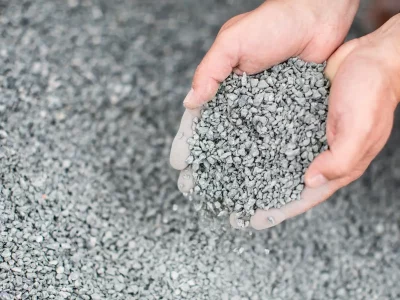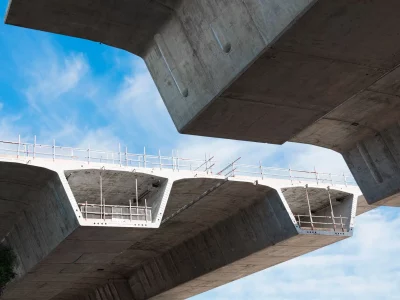Concrete is without doubt the world’s most commonly used building material and an irreplaceable and vital element in the construction of society. Since Roman times, successive civilizations have discovered and harnessed the superior characteristics concrete offers, using this most versatile of materials to create constructions of increasing ambition and complexity.
![]() Here you will find summarized information about low-carbon concrete and its enormous and untapped potential.
Here you will find summarized information about low-carbon concrete and its enormous and untapped potential.
Low-carbon concrete represents a significant advancement in sustainable construction, offering a promising solution to one of the industry’s most pressing environmental challenges.
Traditional concrete production is a major contributor to global CO₂ emissions, but low-carbon alternatives are changing the landscape. Innovations in this field include the development of alternative binders that reduce the carbon footprint by up to 70% and the use of captured CO₂ to strengthen concrete while storing carbon permanently. As the construction sector continues to evolve, low-carbon concrete not only presents an opportunity to reduce environmental impact but also aligns with global efforts to achieve net-zero emissions, making it a crucial component in the fight against climate change.
![]()
Cement acts as a glue that, when mixed with water, secures stone, gravel, and sand to create concrete. Although cement makes up only about 10% of the volume in concrete, it is responsible for as much as 90% of the carbon dioxide emissions associated with the material.
Concrete stands out as the most vital and cost-effective construction material. It’s the most widely used material globally for compelling reasons: its durability, longevity, and resistance to extreme conditions such as weather extremes, fire, moisture, and mold. Not only is concrete fully recyclable, but it also absorbs carbon dioxide over time.
In many cases, concrete is the sole material that satisfies the stringent standards for quality and durability in construction. Looking ahead, concrete will continue to be indispensable in forging strong and sustainable communities.
Concrete with a lower climate impact, made with alternative binders, is called low-carbon concrete.
*The amount of added alternative binders depends on the type of construction and exposure class.
Low-carbon concrete is designed to have a reduced carbon footprint compared to standard concrete, yet it delivers equal or superior quality, functionality, and performance.
This low-carbon version of concrete is achieved by substituting portions of the cement with alternative binders and fine-tuning the overall binder content.
*Note: Standard concrete refers to concrete produced without the use of alternative binders.
![]()
Alternative binders are essentially mineral-based substances that share similarities with cement but produce considerably less carbon dioxide. These binders chemically react to serve as the adhesive in concrete, holding together various aggregates.
At Thomas Concrete Group, we currently utilize by-products from other industries as alternative binders, which would otherwise require disposal or other forms of management. Some alternative binders are derived from natural sources.
Our primary choices for alternative binders are:
Slag: Specifically, blast furnace slag from the steel and iron sector. This by-product is ground into a fine powder and can substitute a significant portion of cement in concrete.
Fly ash: Sourced from the combustion of coal, this by-product is collected after flue gases are cleaned at certain coal-fired power stations with non-toxic burning processes.
The alternative binders we employ are free from any toxic or hazardous elements and comply with rigorous chemical regulations. We, along with our suppliers, conduct thorough testing on all alternative binders to ensure they meet the stringent criteria set by standards and legislation.
![]()
Concrete continuously undergoes a process known as carbonation, where it naturally absorbs carbon dioxide without altering its structural integrity. This process is perpetual in concrete structures and is not a recent discovery.
The phenomenon of carbonation has been recognized by the UN in an IPCC climate report, acknowledging concrete’s ability to sequester carbon. There exist established procedures and benchmarks for quantifying the carbon uptake of concrete.
Over the course of its existence, a concrete structure can reabsorb approximately 20% of the carbon emissions it originally produced. Notably, around half of this absorption occurs within the first 25 years, assuming the structure has a 100-year lifespan.
![]()
A sustainable soeciety is built with low-carbon concrete.
Utilizing low-carbon concrete is the single most important measure for diminishing the environmental footprint of the construction sector.
In our commitment to promoting sustainable practices, we are constantly refining “Our Green Offer” to make the selection and application of low-carbon concrete more accessible. Concurrently, our research and development efforts are dedicated to realizing the goal of net-zero emissions in concrete construction.
Collaboration is essential at the design phase, involving all stakeholders, especially concrete manufacturers, to ensure the success of net-zero emission concrete projects.
As The Concrete Specialists, we take pride in contributing our extensive knowledge and expertise throughout the entire span of the construction process.
The Colosseum in Rome was largely built with concrete, and the Pantheon’s concrete dome is still the world’s largest unreinforced concrete dome.
The Romans’ use of concrete freed the building projects of the time from the limitations of stone and brick, which enabled the revolutionary constructions of the time, both in terms of complexity and size. But after the fall of the Roman Empire, concrete construction technology fell out of practice, and it was only in the middle of the 18th century that the technology was redeveloped.

Concrete is a composite material made of ballast – usually sand, crushed rock or stones – and a binding agent made of Portland cement and water. Because these ingredients can be found locally almost everywhere, concrete is considered easy to produce.
Ballast can be replaced by recycled material while ash and slag can be used instead of Portland cement. Supplementary cementitious materials (SCMs) play a crucial role in enhancing the properties of concrete while reducing environmental impact. However, this is only one expression of the versatility of concrete.

Across the world, over 24 billion tons of concrete are used annually in projects as diverse as the construction of homes, commercial buildings, infrastructure, and power plants. Its uses are almost too many and varied to mention, which is unsurprising when considering what concrete is capable of:

Concrete’s popularity as a building material is based on many characteristics, not least its versatility. Special concrete can be produced to fulfill a wide variety of specific functions, including aesthetically adapted concrete for visual purposes, fiber reinforced concrete, self-compacting concrete, and high-strength concrete, among many more.
Concrete is much more than a high-quality construction product. It’s one of the world’s most sustainable and versatile building materials.
For thousands of years, concrete has been a popular and widely used construction material. There are many reasons for this, not least its natural beauty and ability to be formed and used creatively. From sustainability to health, safety and durability, concrete is a material defined by outstanding functional performance and real benefits.
Over its entire lifetime, concrete is an efficient absorber of CO2.
Concrete is highly durable, fulfilling its intended function for long periods of time.
Because concrete can be manufactured close to where it’s needed, transport distances and their climate impact can be minimized.
Concrete’s high density helps insulate buildings, lowering energy consumption and costs and reducing our climate footprint.
Concrete can withstand moisture, fire and the effects of extreme weather.
Concrete has effective noise insulation properties, contributing to calm, quiet interior environments.